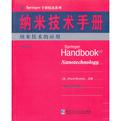纳米技术手册
出版时间:2013-1 出版社:哈尔滨工业大学出版社 作者:布尚 编
内容概要
《Springer手册精选系列•纳米技术手册:纳米技术的应用(第7册)(第3版影印版)》内容包括:45.千足虫:基于原子力学显微镜数据存储系统的纳米技术;46.纳米机器人;47.微机电系统/纳机电系统和微机电生物系统/纳机电生物;48.微米/纳米机械中的摩擦和磨损;49.微机电系统/纳机电系统中的失效机制;50.微机械结构的机械特性;51.微机械产品的大批量生。
作者简介
编者:(美国)布尚(Bharat Bhushan)
书籍目录
缩略语 Part G 工业应用 45.千足虫:基于原子力显微镜数据存储系统的纳米技术 45.1 千足虫的概念 45.2 热力学原子力显微镜的数据存储 45.3 阵列设计、技术和制造 45.4 阵列的特性 45.5 三端悬臂的设计 45.6 x,y,z介质微型扫描仪 45.7 首次32×32阵列芯片写牍结果 45.8 聚合物介质 4.5.9 读取信道模型 45.10 系统特性 45.11 结论 参考文献 46.纳米机器人 46.1 纳米机器人概述 46.2 纳米量级的驱动 46.3 纳米机器人的操作系统 46.4 纳米机器人的装配 46.5 应用 参考文献 Part H 微/纳米器件的可靠性 47.微/纳机电系统和生物微,纳机电系统:材料、器件、仿生技术 47.1 微/纳机电系统基础 47.2 硅及相关材料的纳米摩擦学和纳米力学研究 47.3 微/纳机电系统的润滑研究 47.4 基于硅和多晶表面生物分子的摩擦学研究以及微纳米级颗粒治疗与诊断 47.5 带有粗糙度诱导超疏水、自清洁、低附着的表面 47.6 组件级研究 47.7 结论 47.A 微米-纳米制造技术 参考文献 48.微米-纳米机械中的摩擦和磨损 48.1 从单粗糙到多粗糙摩擦 48.2 纳米反应器概述 48.3 结束语 参考文献 49.微/纳机电系统中的失效机制 49.1 失效模式和失效机制 49.2 静摩擦和充电相关的失效机制 49.3 蔓延、疲劳、磨损及封装相关的失效 49.4 结论 参考文献 50.微机械结构的机械特性 50.1 薄膜基板的机械性能检测 50.2 测量机械性能的微机械结构 50.3 机械性能的检测系统 参考文献 51.微机械产品的大批量生产和市场稳定性 51.1 背景 51.2 制造策略 51.3 强大的制造业 51.4 稳定的市场特征 参考文献 52.微/纳米系统的封装和可靠性问题 52.1 微机电系统封装简介 52.2 密封和真空封装及应用 52.3 散热问题和可靠性封装 52.4 未来趋势和总结 参考文献 Part I 技术的融合和纳米技术的管理 53.纳米技术的管理:社会的、伦理的和人权的问题 53.1 社会科学背景 53.2 人类对纳米技术的影响 53.3 纳米技术的调节 53.4 纳米技术的文化背景 53.5 结论 参考文献 主题索引
章节摘录
版权页: 插图: 47.1.3 Introduction to BioMEMS/BioNEMS BioMEMS/bioNEMS are increasingly used in commercial and defense applications(see,e.g.,(47.54—61)).They are used for chemical and biochemical analyses(biosensors)in medical diagnostics(e.g.,DNA,RNA,proteins,cells,blood pressure and assays,and toxin identification)(47.61,62),tissue engineering(47.63-65),and implantable pharmaceutical drug delivery(47.66-68).Biosensors,also referred to as biochips,deal with liquids and gases.There are two types of biosensors.A large variety of biosensors are based on micro—nanofluidics(47.61,69—71).Micronanofluidic devices offer the ability to work with smaller reagent volumes and shorter reaction times,and perform analyses of multiple types at once.The second type of biosensors includes micro—nanoarrays which perform one type of analysis thousands of times(47.72-75). A chip,called lab—on—a—CD,with micro—nanofluidic technology embedded on the disk can test thousands of biological samples rapidly and automatically(47.69).An entire laboratory can be integrated onto a single chip,called a lab—on—a-chip(47.61,70,71).Silicon—based disposable blood—pressure sensor chips were introduced in early 1990s by GE NovaSensor for blood—pressure monitoring (≈25 million units in 2004).A blood-sugar monitor,referred to as GlucoWatch,was introduced in 2002.It automatically checks blood sugar every 10min by detecting glucose through the skin,without having to draw blood.If glucose is out of the acceptable range,it sounds an alarm so the diabetic patient can address the problem quickly.A variety of biosensors,many using plastic substrates,are manufactured by various companies including CLARA,Agilent Technologies,Calipertech,and I-STAT. The second type of biochips—micro—nanoarrays-is a tool used in biotechnology research to analyze DNA or proteins to diagnose diseases or discover new drugs.Also called DNA arrays,they Can identify thousand of genes simultaneously(47.57,72).They include a microarray of silicon nanowires,roughly a few nm in size,to selectively bind and detect even a single biological molecule such as DNA or protein by using nanoelectronics to detect the slight electrical charge caused by such binding,or a microarray of carbon nanotubes to detect glucose electrically.
编辑推荐
《Springer手册精选系列•纳米技术手册:纳米技术的应用(第7册)(第3版影印版)》内容包括:千足虫:基于原子力学显微镜数据存储系统的纳米技术;纳米机器人;微机电系统/纳机电系统和微机电生物系统/纳机电生物;微米/纳米机械中的摩擦和磨损;微机电系统/纳机电系统中的失效机制;微机械结构的机械特性;微机械产品的大批量生产产和市场稳定性等。
图书封面
评论、评分、阅读与下载
